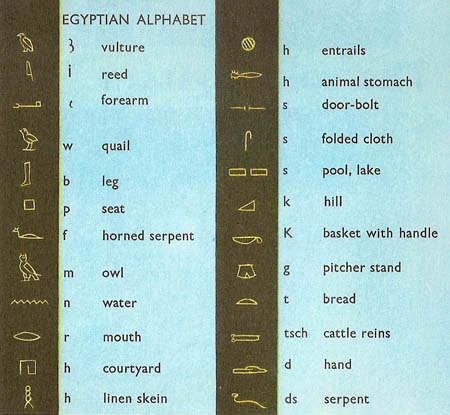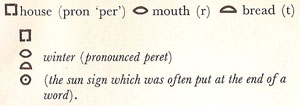hieroglyphics

Figure 1. The Rosetta Stone is very hard black basalt. It was found in July 1799 by a French artillery officer named Boussard a few miles from Rosetta (quite near Alexandria). Its writing was deciphered by the famous French scholar Jean François Champollion (1790–1832) although the first word was deciphered by the Englishman Thomas Young in 1819.

Figure 2. The ancient Egyptian alphabet.

Figure 3. How hieroglyphics was deciphered.

Figure 4. Egyptian numerals.
On 2 July 1798, a powerful French army landed in Egypt under the command of Napoleon Bonaparte. Egypt was an ally of England, with whom the French were at war, and the French leader hoped to damage his chief enemy by this expedition.
In Napoleon's train there were also 175 scholars, who were told to discover and to study all they could find of the ancient civilizations of Egypt. The military expedition was a complete failure, but the scientific investigation bore some marvelous fruits. The scholars found a great quantity of remains which revealed to the world, for the first time, the nature of ancient Egypt.
The most important find was a block of black basalt inscribed to the glory of the pharaoh Ptolemy V, in hieroglyphs (the first writing used in Egypt), in demotic (popular Egyptian writing), and in Greek. So, at last, by comparing the Egyptian word for word with the Greek text, it was possible to see what the Egyptian meant. Since the stone was found in a fort near Rosetta (Rashid) on the Nile, it passed into history as the Rosetta Stone. On the capitulation of Egypt to England in 1801 the Rosetta STone was shipped to England and is now in the British Museum.
The very first writing in Egypt was hieroglyphic, from the Greek hieros ('sacred') and gluphe ('carving'). It began to be used about 3,200 BC, at the time of the great pyramids, and it is one of the most ancient forms of writing in the world.
How does it work? Imagine a man who does not know how to write and wants to convey the idea of a person, an animal, or the Sun or a boat on a piece of rock or stone. As he does not know the letters of the alphabet, all he can do is to draw what he wants to represent. He might draw a circle to represent the Sun; a sail to represent the wind; a boat to represent a sea journey, and so on. That is exactly what the first Egyptians did. But soon the difficulties began; these signs and drawings were unsuitable for abstract notions like goodness or thought, and useless for verbs such as living, waiting, and thinking. Nor were they any good for telling one whether the action of thinking occurred yesterday, today, or would occur tomorrow. In fact many ideas were extremely difficult to express at all.
To remedy this state of affairs, the Egyptians gradually, over the centuries,
changed their writing by making each one of their figures represent a sound,
much as we give a sound to each letter. For example, in early hieroglyphs
a picture of a house represented a "house." In time this symbol was simplified
into the sign  .
.
It probably signified the plan of the house and was pronounced "per." The sign thus became a syllable and as such came to be used to compose words in which the sound "per" was required. For example:
 |
We say and write "per," pronouncing the "e." But the Egyptians never wrote vowels; they just pronounced them. Their alphabet was composed of consonants only and of a great number of signs. The Egyptians were not the first people to work out an alphabet. The Phoenician alphabet is earlier and the Egyptians learnt much from it.
How hieroglyphics was decoded
There were the two signs that made it possible for Champollion to decipher hieroglyphic writing. They're shown in Figure 3. Chapollion read the Greek text and found at once that the inscription was dedicated to King Ptolemy. Whenever he might suppose the word "king" to occur, he found a group of signs enclosed in oval rings known as cartouches. So Champollion arranged the letters of the name Ptolemy under the corresponding signs in the cartouche and was able to find out which sign corresponded to which letter in our alphabet. He did the same with the name Cleopatra, the name which is represented in the second cartouche.
Egyptian numerals
The Egyptians wrote the numbers one to nine with short perpendicular strokes with various signs for tens and units of tens beyond 10 (Figure 4). When forming a number, they used the signs as many times as were necessary.
